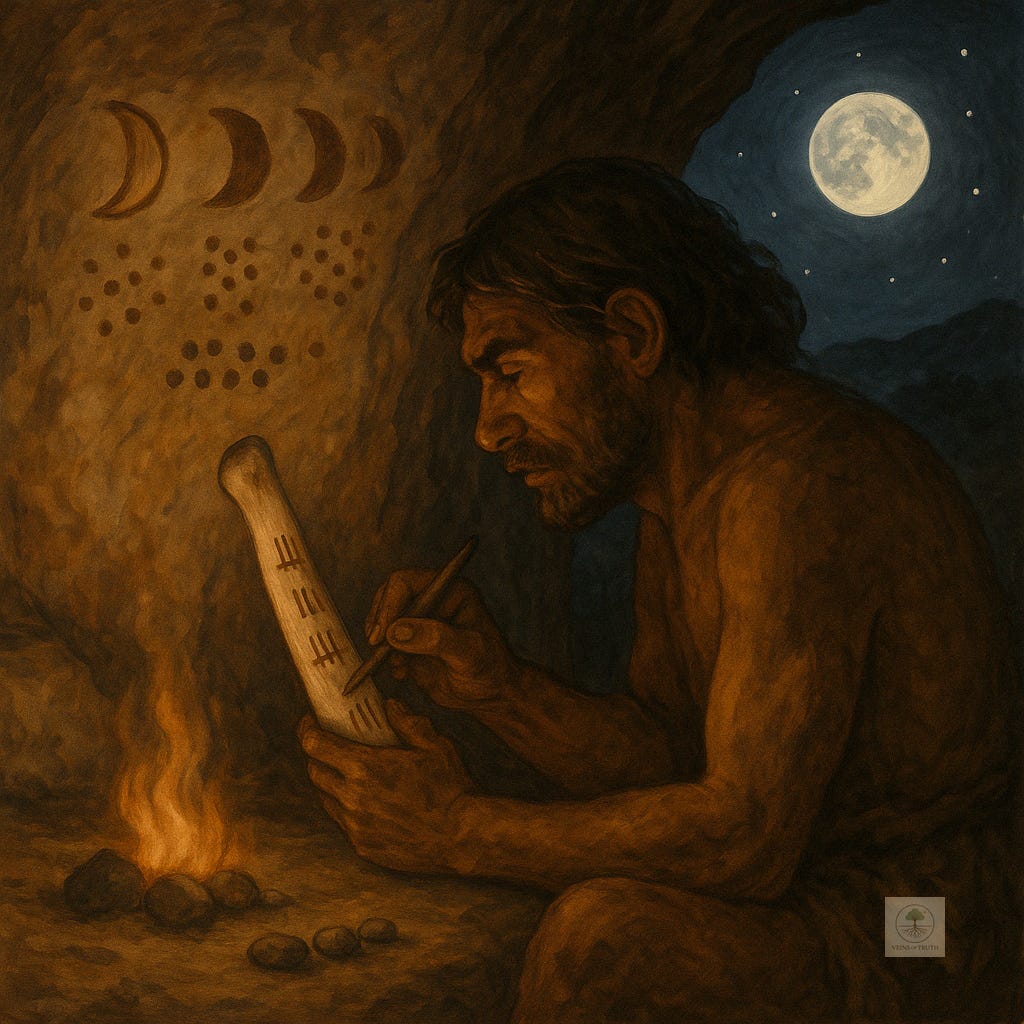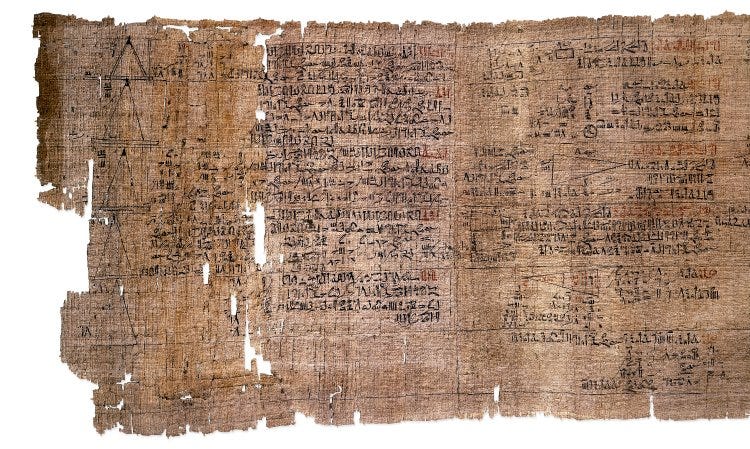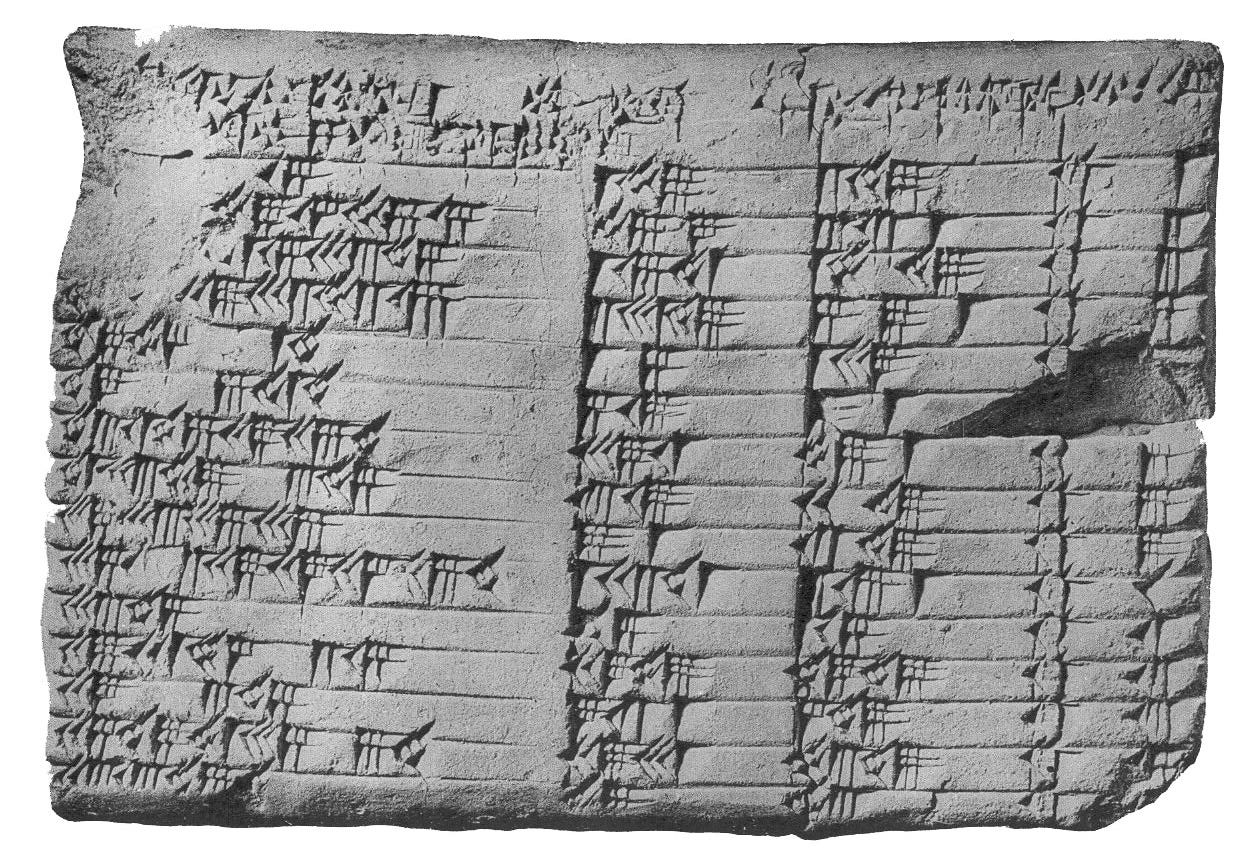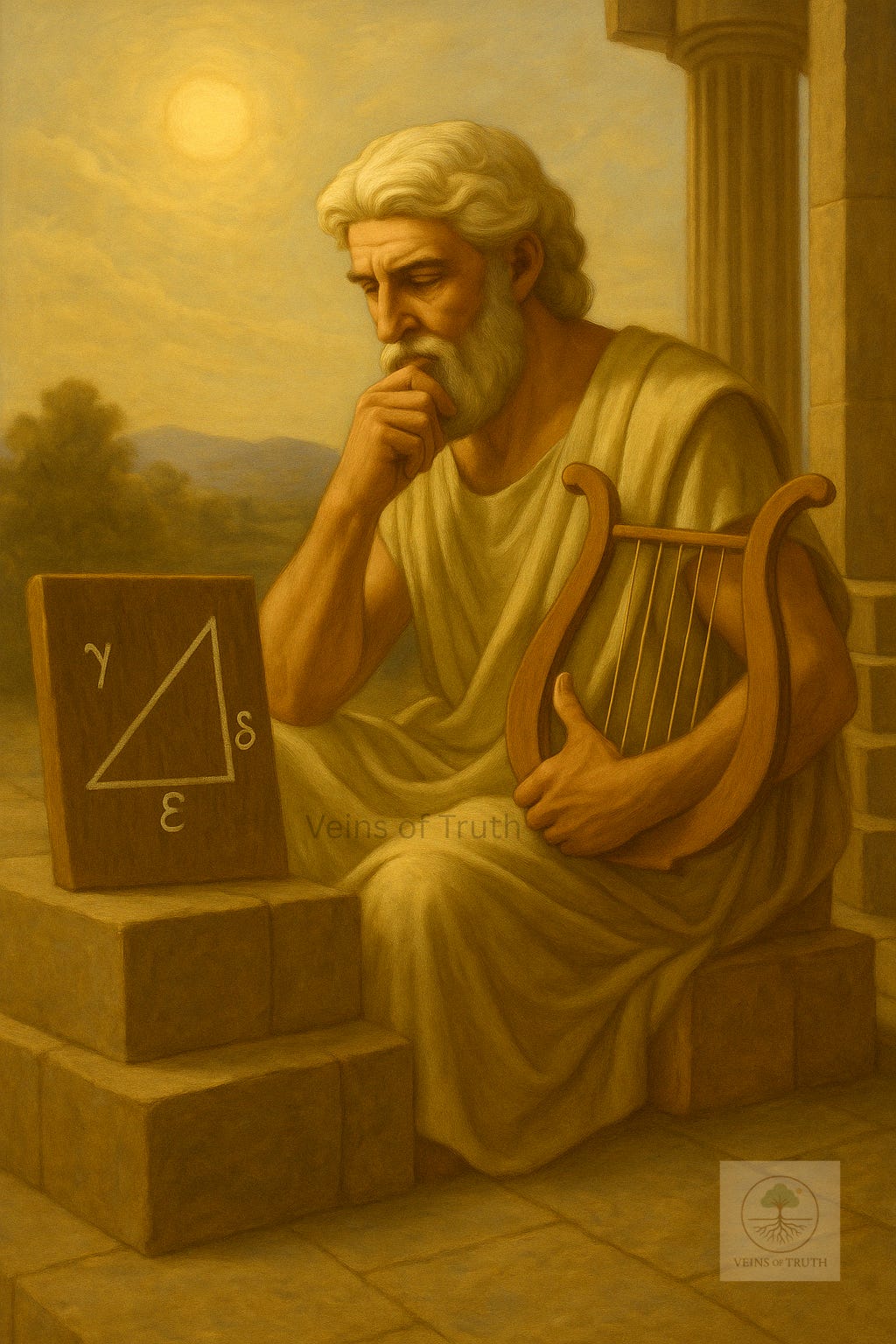Mathematics: The First Language of the Universe
The Origins Series: Tracing Every Subject Back to the Truth. A complete timeline of how every field of knowledge began, evolved, was manipulated, and how it connects back to divine order. ARTICLE #1
Long before humanity built cities, spoke in structured languages, or recorded history, we noticed pattern. From the marks of ancient bones to the symmetry of galaxies, mathematics was the first whisper of divine order.
I. In the Beginning, There Was Pattern
Before there were alphabets, there were numbers. Before there were scrolls, there were tallies. The first sign that humans were becoming something more than instinctual beings was their ability to notice, count, and replicate.
Somewhere around 20,000 BCE, deep in prehistoric Africa, someone carved deliberate markings into a bone, now called the Ishango Bone【1】. These weren’t scratches of boredom. They were groupings, sequences, prime numbers. It may have been a record of the moon【2】. It may have been an early calendar. But one thing is certain: it was the beginning of mathematics.
Across the world, other early humans were doing the same. They tracked the sun’s rising, the moon’s fullness, the days between floods. They noticed how two stones added to three stones always gave five. These weren’t discoveries of abstract logic, they were signs of cosmic consistency. It was as if the world was speaking in code, and humans were learning to listen.




II. Civilizations of Numbers
As the earliest civilizations rose, mathematics became their backbone. In Sumer, c. 3100 BCE, scribes developed a base-60 system, the same one we still use to measure time. 【3】They used it to record trade, calculate crop yields, and plan temple architecture【4】. Their math was cuneiform, pressed into clay tablets, preserved through fire and empire.
In Egypt, geometry was born out of necessity. Each year, the Nile’s floods erased property lines and each year, priests and engineers re-measured land using ropes, stakes, and stars【5】. Their knowledge allowed them to construct pyramids with unparalleled alignment and proportion, structures that still whisper secrets to modern minds【6】.
Babylonians solved quadratic equations and developed early trigonometric tables【7】. What most people never learn is that long before Pythagoras was born over a thousand years before, in fact the Babylonians were already working with right triangles. Their knowledge wasn’t speculative or symbolic. It was recorded, calculated, and preserved in clay.
A tablet now known as Plimpton 322, dated to around 1800 BCE, contains a list of Pythagorean triples , whole number sets that satisfy the formula a² + b² = c². This was not a coincidence. It was intentional, systematic, and deeply advanced. The numbers are arranged in rows and columns using the sexagesimal (base-60) system originally developed by the Sumerians, which the Babylonians had preserved and expanded upon. The level of mathematical accuracy is so precise that in 2017, researchers confirmed it to be the earliest known trigonometric table in human history【7A】.
This trigonometry wasn’t built on angles, as we do today, but on side ratios a system rooted in proportion, not degrees.
Yet in nearly every classroom, it is Pythagoras who is taught as the originator of this knowledge. His name is attached to the theorem, his legacy etched into geometry lessons across the world. But he lived more than a millennium later, and there is no evidence he discovered the principle himself. At most, he formalized it. The foundation had already been laid not in Greece, but in Mesopotamia.
The credit, however, was quietly redirected.
As European scholars revived Greek texts during the Renaissance, they rarely traced the origins of that knowledge deeper than the Mediterranean. Civilizations like Babylon were treated as primitive, their contributions overlooked or dismissed. The triangle, once etched in Mesopotamian clay, was rebranded as a Greek invention and the true authors were forgotten.
But Plimpton 322 still survives. Cracked, weathered, and silent but undeniable. A mathematical artifact that challenges the official narrative. It proves that the earliest trigonometry wasn’t born in Europe. It was born in the riverbeds of Sumer and refined in the libraries of Babylon. In a world where mathematics reflected not just logic, but cosmic harmony. 【7B】【7C】【7D】
The irony is that the theorem encoded in Plimpton 322 , now known globally as the Pythagorean Theorem was neither discovered nor written by Pythagoras himself. There are no surviving writings from Pythagoras. No original proof. Just tradition and attribution, written centuries later. Meanwhile, Babylonian records show this knowledge being used with precision over a millennium earlier. 【7E】【7F】
Historians now recognize that civilizations like Babylon, India, and Egypt had already grasped these mathematical truths, but during the Renaissance the credit was handed to the Greeks. This did not happen through evidence, but through Eurocentric admiration. This wasn’t just a shift in names. It was a quiet erasure. A brilliant mathematical culture was reduced to a footnote, and a borrowed truth was renamed.
The Indus Valley civilization designed perfectly gridded cities and standardized weights for commerce, proof that numerical knowledge was being woven into infrastructure and justice.【8】
We don’t know the names of the first mathematicians. Their contributions weren’t signed like modern textbooks. These were priesthoods, astronomers, builders and anonymous guardians of divine structure. Yet their legacy remains in the very shape of the world.
III. Numbers Become Philosophy
The Greeks took what earlier civilizations had systemized and asked a new question:
“Why does it work?”
Pythagoras is often remembered as the philosopher who believed that numbers were not just useful, but sacred【9】. He taught that the universe was composed of harmonic ratios. Teaching that music, planets, and souls moved according to the same mathematical laws. To him numbers weren’t symbols. They were substance.
Despite his fame, Pythagoras left no writings behind. What we know of him comes from traditions passed down centuries later, often blurring myth and reality. The theorem that bears his name existed in Babylonian and Indian texts long before he lived, and the mathematical legacy we associate with him may have belonged just as much to the cultures he inherited from, if not more.
Still, the Greeks contributed something new: they made mathematics a philosophy of truth. With figures like Euclid, Archimedes, and later Apollonius, they asked not only how numbers worked but why. And in doing so, they opened a door that would be walked through by civilizations across the world.
Euclid, working in Alexandria around 300 BCE, compiled one of the most influential books in human history: Elements, a 13-volume treatise on geometry and number theory that would shape mathematics for nearly 2,000 years【10】.
Despite the title, this was not a “table of elements” like the modern periodic chart. Elements was a logical system. A step-by-step unfolding of mathematical truths, beginning from a few simple definitions and postulates, and building into a complete architecture of reason.
Euclid didn’t invent geometry. His brilliance lay in organizing the inherited knowledge of earlier cultures like Babylonian arithmetic, Egyptian land-surveying, and Greek philosophical logic into a rigorous, deductive framework. Though his system was groundbreaking, it was not flawless. Some foundational gaps, especially in his treatment of ratios and irrational magnitudes, would remain unresolved until scholars like Omar Khayyam corrected them centuries later. Though he cited no sources, historians now recognize that much of what appears in Elements reflects the intellectual labor of civilizations before him.
What made Euclid’s work revolutionary was not its originality, but its clarity. Each proposition was proved like a chain, link by link, forming a structure so solid that it became the foundation of mathematics education for two millennia — from the Islamic Golden Age to medieval Europe, and well into the modern era.
Elements was more than a book. It was a blueprint not just for math, but for thinking itself.
Archimedes, the great mathematician of 3rd-century BCE Syracuse, explored infinite processes, geometric summation, and mechanical balance developing ideas that centuries later would resemble the core of calculus【11】. Using what is now called the method of exhaustion, he calculated areas, volumes, and centers of mass by slicing shapes into smaller parts and summing them — a geometric approach to understanding continuous change.
But Archimedes had no algebra. He lacked symbols, variables, or generalized equations. Those tools would emerge much later, through the works of Indian and Islamic mathematicians, and eventually power the formal system of calculus introduced by Newton and Leibniz. His insights, however, were so advanced that modern scholars now recognize them as a conceptual precursor to integral calculus — long before the West gave it a name.
For the Greeks, mathematics was more than a tool — it was a window into reality itself. Numbers revealed structure, symmetry, and harmony. They suggested that the universe operated according to fixed laws and that the human mind had been designed to comprehend them.
IV. The Golden Era of Preservation and Expansion
When Europe fell into intellectual darkness, it was the Islamic world that carried the torch of mathematics forward. From the 8th to 14th centuries, scholars across Baghdad, Cairo, Cordoba, and Samarkand preserved, translated, and radically expanded upon Greek, Indian, and Babylonian math【12】. Al-Khwarizmi, working in the House of Wisdom in Baghdad, developed systematic methods for solving equations — giving the world both the word “algebra” and the very concept of algorithms【13】. His writings didn’t just preserve earlier ideas — they reshaped them into practical, universal systems that would guide mathematics for centuries.
Keep reading with a 7-day free trial
Subscribe to VEINS OF TRUTH to keep reading this post and get 7 days of free access to the full post archives.









